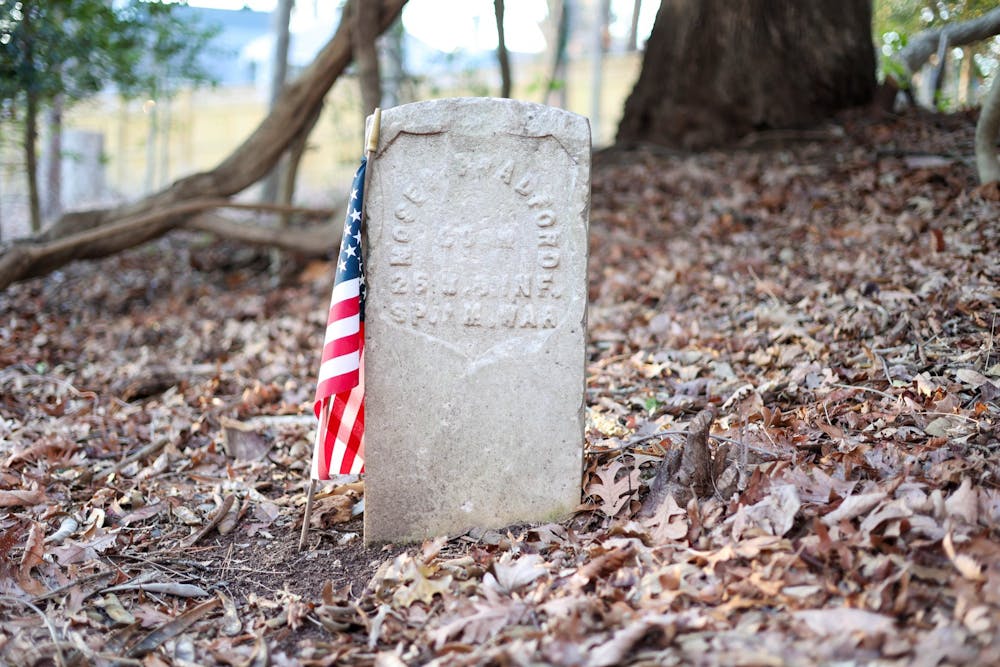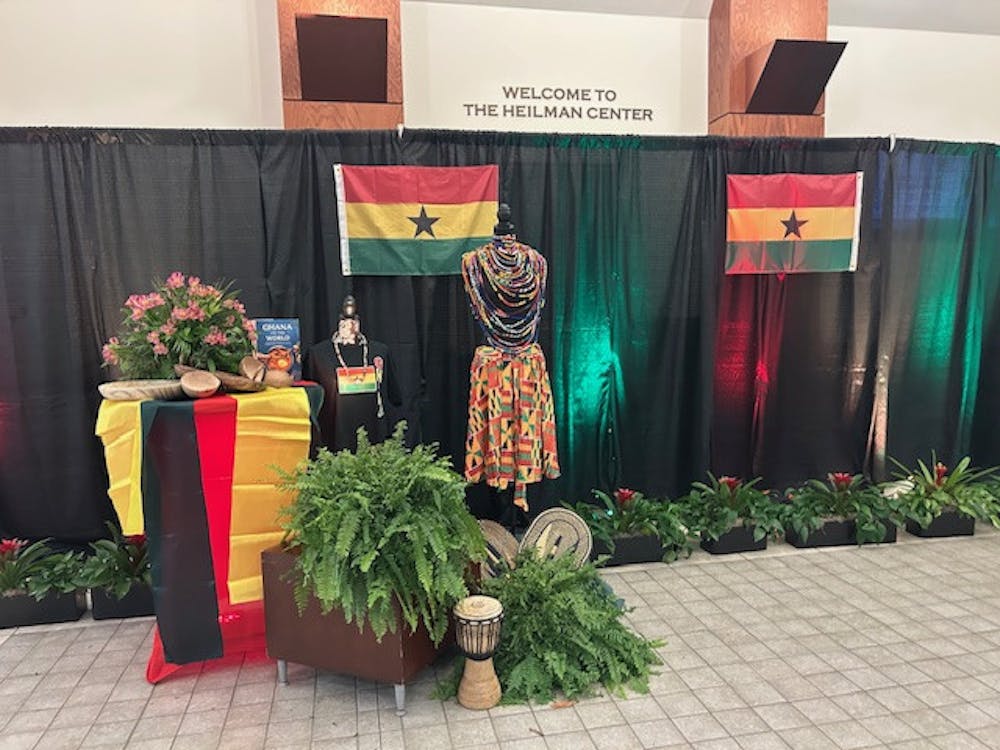Editor’s note: Jackie Llanos participated in clean-up efforts at the Sons and Daughters of Ham Cemetery as part of Professor Elizabeth Baughan’s Introduction to Archeology class.
This ten-minute story highlights the efforts of some community members to restore the Sons and Daughters of Ham Cemetery. Hosted and produced by Jackie Llanos.
JACKIE LLANOS: Just last year, the University of Richmond released a report about a burying ground of enslaved people on campus. Despite the increased interest in the history of the university’s land, most students don’t know about another cemetery just beyond UR’s property line.
ELIZABETH BAUGHAN: A student had told me she had found a gravestone here, and when I first came, I couldn't find it. It was so overgrown and thick with underbrush, and thorns, and poison ivy and growth that I couldn't find it at all.
LLANOS: That is Elizabeth Baughan, a classics and archeology professor at the University of Richmond, talking about her attempts to find the Sons and Daughters of Ham Cemetery, which was founded in 1873 by emancipated people who had been enslaved in the land that is now owned by the university. She found the cemetery, eventually, with the help of a librarian and a group of volunteers. Our conversation took place as we walked around the cemetery.
BAUGHAN: We sort of had to bushwhack to get back to where it was.
LLANOS: Although the acre plot off a dead-end road is the final resting place for as many as 50 people, it is hard to tell through the camouflage provided by the holly trees and wisteria vines. There are only two recognizable gravestones, both belonging to Moses Bradford Sr’s. children, the man who bought the land the cemetery is on once he gained his freedom. Moses Bradford Junior’s gravestone stands upright adorned with an American flag, to indicate his status as a veteran of the Spanish-American War.
BAUGHAN: Several of the largest trees like this one behind Moses Bradford's gravestone may have been here. You can imagine a kind of a cemetery on the hill, that would have a few very tall, majestic trees, kind of providing shade for visitors.
LLANOS: And the other is toppled over a marble base about a dozen steps away.
Enjoy what you're reading?
Signup for our newsletter
BAUGHAN: This is one of the higher-end gravestones available at the time in that it's made of marble, it's finely carved. It is wide and thick. That is it's not just a thin piece of marble that may be reused from something.
LLANOS: The details of the two gravestones act as pieces of a puzzle that Baughan’s class, UR researchers and the non-profit Friends of Sons and Daughters of Ham are trying to solve through archeological methods that have been used at other Black cemeteries in Richmond.
BAUGHAN: In the cleanup that we've been doing here for the last year, a couple of times we've used probes to gently sort of poke through the soil and see if we might hit a gravestone that's buried just beneath the surface. But we've not been able to identify any buried gravestones that way, not yet at least.
LLANOS: Is there any other method you could use to find these gravestones?
BAUGHAN: One hope we had initially was that we could use a method that has been successful out of Eastern Cemetery, where a very high-quality drone photo can be examined for slight depressions. But here, I think because we're on such a slope, and we've got so much tree root activity, we just weren't able to see the same level of detail.
LLANOS: Even with these setbacks, the artifacts left behind carry more clues about the location of graves and the council hall that burned down in the 1940s due to a wildfire.
BAUGHAN: So this whole plot here is a square that has the granite posts at the four corners, and then it would have steel bars acting as kind of like a fence connecting them. Oftentimes, you'd have pillars on either side of the threshold, we don't see those here. But if we were to excavate here, you might be able to find the kind of a door sill or something. But because the land is so sort of bumpy with a lot of depressions, I would be hesitant to do any kind of real excavation here for fear of disturbing graves that we know are absolutely in this location.
LLANOS: So what do you think it says about, you know, Richmond, in general, that this cemetery is in a state where you can hardly tell it's a cemetery?
BAUGHAN: It's certainly not the fault of the people who are connected with people buried here, because in some cases, they're only just learning that their ancestors were buried here.
LLANOS: The majority of Black families who lived in the area surrounding the cemetery were forced off their land in the 1950s when the city took it under eminent domain to build a school. No school was ever built on the land after the homes were bulldozed.
BAUGHAN: The families get dislocated, get moved to another part of town. And then it's much harder to come and maintain the graves of their loved ones. There just hasn't been public funding to help maintain these sacred spaces.
CAROLYN MOTEN: We were up the hill from the University of Richmond, and my sister, my brother and a couple of the other cousins. We used to just run and play and jump around down past the cemetery. And mom used to tell us stay from down on the university but we snuck down through the woods anyway, you know how when you’re growing up, and it was just a lot of fun. Hi, I am Carolyn Bradford Winston Moten, a descendant from the Bandy Field and The Sons and Daughters of Ham.
LLANOS: Moten, a descendant of the Bradford family on her mother’s side, grew up in the area surrounding the cemetery. When she was 11 years old, her family moved to a different county after the city claimed their land for the school construction. At the time, she didn’t know why her family was moving nor the significance of the cemetery she played around.
MOTEN: I just remember vaguely, a couple of stones that kind of stood straight up. There were some that were like level with the ground. But at that time, I guess I wasn't really trying to find out who they were. I knew they were relatives.
LLANOS: As Moten grew up she became more distant from the cemetery. Her family only started talking about the cemetery in the late 90s when the university tried to take the cemetery property. A plan that UR gave up on. However, Moten didn’t visit the cemetery until she received a call from Mary Ann Rollings, who also grew up in the area and whose family employed Moten’s mother and grandmother. Rollings wanted Moten’s help in taking care of the cemetery.
MOTEN: When Mary Ann called and was getting some information was like couldn't say no.
LLANOS: Moten said the only thing that bothered her about the situation was that she didn’t get involved sooner because her mother didn’t tell her about her family’s history. Why do you think your mom never talked about it with you?
MOTEN: Um, I'm not really sure. I don't know whether they didn't want us to know if it was a cultural thing. I don't know exactly what to say it was, but they just didn't. And I guess we didn't know to ask. That's why we are where we are today.
LLANOS: How does it make you feel that it took this long for you to find out the history of your family?
MOTEN: I think it's kind of sad in a way. But now that we know, we have to embrace it and go from there with it. It's really been beautiful.
LLANOS: One of Moten’s most recent visits to the cemetery was over the summer for an event to honor Buffalo soldiers, a term used to refer to Black soldiers.
MOTEN: When they did the taps I was almost in tears. Matter of fact, one of the men gave me the, I guess it was the shells from what they shot off. And I took those home.
MCKENNA DUNBAR: In July, I did have the opportunity to meet some of the family members of the former Buffalo Soldier that resides there.
LLANOS: How was that experience for you?
DUNBAR: It was nice to see that they were so happy about community involvement because I can't imagine what it was like for just decades and decades no one taking the time to learn about that history. Hi, my name is McKenna Dunbar, and I am a junior at the University of Richmond.
LLANOS: Dunbar is also the founder of a youth environmental nonprofit. Her passion for sustainability and her time working as a mortician’s assistant drove her to become a volunteer for the Sons and Daughters of Ham Cemetery. She participated in clean-up efforts and joined the Sons of Ham Basecamp, a platform for archival and historical research created by UR and local community members. Though Dunbar is grateful to be involved in the cemetery’s restoration, the work sometimes took an emotional toll.
DUBAR: I really reflected in that moment when I was sitting on top of the hill overlooking the shouting neighborhood. And I thought to myself, I can't imagine what the members of this former community went through with the unmarked graves, them not having support them, the general community of Richmond not caring enough about their struggles as African Americans. It really made me think about my own place in history and my ancestors who came before me as a Black person in society. Thinking about how this land used to be the capital of the Confederacy and just thinking about the type of community that Black Americans had to form here in order to survive.
LLANOS: For decades, the resting place of people formerly enslaved in the land where University of Richmond students reside had been forgotten, overgrown. Baughan, Dunbar and Moten plan to continue their efforts to remember the people who built a thriving community right outside the land where they had been enslaved.
MOTEN: I'm hoping that at my age that we will be able to keep making the connections and making efforts to keep it cleaned up. Like I said, Mary Ann has been wonderful with all that. So it's just kind of embracing all of her expertise to try to keep things going, so it won't fall back again.
Contact editor-in-chief Jackie Llanos at jackie.llanoshernandez@richmond.edu.
Support independent student media
You can make a tax-deductible donation by clicking the button below, which takes you to our secure PayPal account. The page is set up to receive contributions in whatever amount you designate. We look forward to using the money we raise to further our mission of providing honest and accurate information to students, faculty, staff, alumni and others in the general public.
Donate Now



